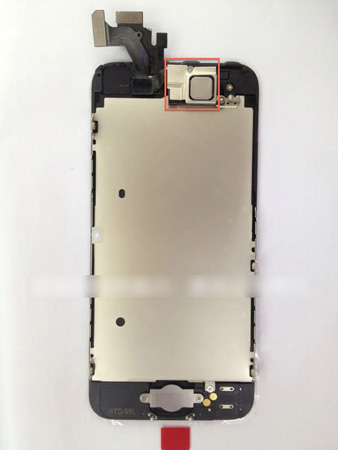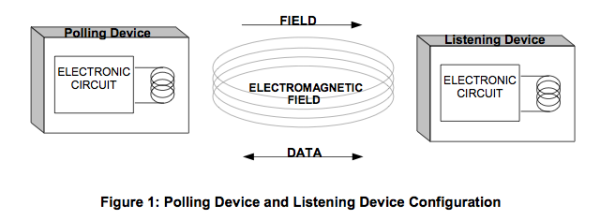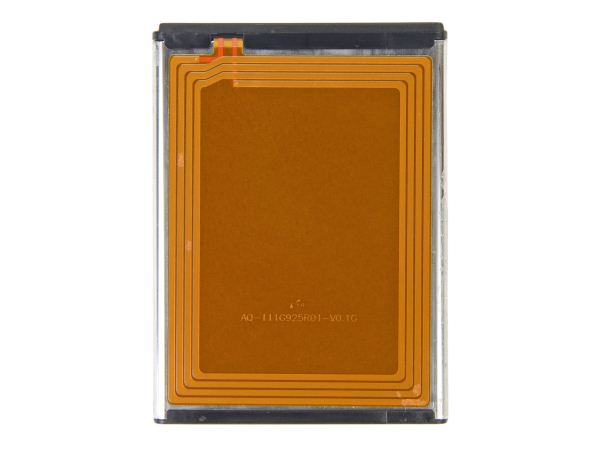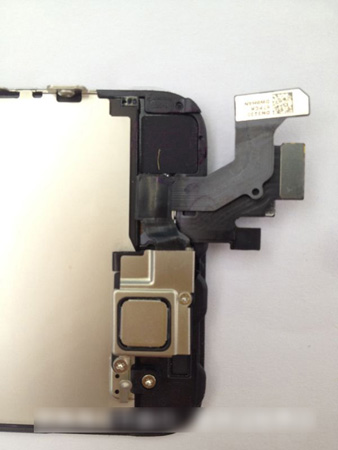Preparing for the iPhone Next: Rumors Analyzed
by Brian Klug & Anand Lal Shimpi on August 27, 2012 9:40 PM EST- Posted in
- Smartphones
- Apple
- Mobile
- iPhone
NFC, Unlikely
The most recent rumor is that this mysterious square chip (occluded by an EMI can) is an NFC combo controller and antenna, based purely on its square dimensions.

The NFC "chip" ensquared in red
Given the primarily metal backside of the new iPhone, it's highly unlikely that NFC is in the cards for this generation. In fact, given the very little space at top and bottom dedicated to those glass RF windows, you can almost entirely rule it out.
NFC operates on the 13.56MHz ISM band, which has a relatively large wavelength, at 22.1 m. Making a traditional dipole antenna that radiates at all given the constraints of a smartphone package is thus a big challenge, considering that smartphones are maybe 5-inches tall at maximum, to say nothing of the supposed upcoming iPhone's longest linear dimension.

From the NFC Forum Analog Specification
As a result almost all NFC antennas are big inductors and work using a magnetic field coupled between a host and peer device. Since we're talking about an inductor, NFC antennas use as big of a coil of wire as possible with as many wires as possible tightly wound together, and thus often use as big of an unbroken 2D plane as they can get on the device. In the smartphone space, basically all NFC antennas to date are simply flat spirals on a PCB. Whether this gets hidden on top of the battery like what Samsung has done in recent devices, or printed on the back battery cover like earlier devices, the antenna is ultimately a big square or circle with as big and dense of a coil as possible.

Galaxy Nexus Battery and NFC Antenna Coils (Courtesy iFixit)
Getting a good inductor into the device is important because how much inductance your antenna has will determine maximum coupling distance and ease of alignment. It shouldn't need saying, but having a huge ground plane (the unibody metal back case) in the way of your NFC antenna will seriously degrade performance, thus only the top or bottom windows are logical places to put it.
It's this last point which makes us very skeptical about the top or bottom RF windows being used for a relatively small NFC loop – not because such a thing is impossible – but rather because of how terrible the resulting ease of alignment and maximum coupling distance would be. Most NFC implementations at present place the inductive coils as near to the center of the device as possible, partly because this is the most optimal way to maximize the area which can be dedicated to it, partly because it makes alignment natural. With an NFC antenna at the extreme top or bottom, alignment with non-iPhones (for example, payment tokens or reader tags) becomes a much more confusing task, and that doesn't seem like the Apple-like level of polish everyone is waiting for to drive NFC adoption.

There's also a healthy number of signaling pins in the flex cable leaving the mystery chip, some of which appear to be signaling for the front facing camera which is part of the assembly, others for earpiece, proximity, and ambient light sensor. In addition this assembly also is obviously the assembled display and touch stack. When you consider the inclusion of in-cell touch sensing which has been rumored for the upcoming iPhone, and the requirement for time multiplexing of both display driving and touch sensing signals (to mitigate interference and make this possible), it's more likely that the components under that heavily shielded (and grounded with a big spring finger) EMI can are the touch and display controller combo that need to work in conjunction for in-cell to be possible.
The inclusion of Passbook in iOS 6 is the most often-cited piece of evidence for Apple including NFC, which seems a bit paradoxical since Apple hasn't disclosed at all whether it would favor NFC or a Bluetooth LE (low-energy) or even QR code based payment token through that gateway.










131 Comments
View All Comments
alxx - Tuesday, August 28, 2012 - link
or buy it to replace iphone 4 with starting to fade batteriesplext0r - Tuesday, August 28, 2012 - link
That's my dilemma. IPhone "Next" or SGS3. :) I currently have the iPhone 4.ltcommanderdata - Tuesday, August 28, 2012 - link
Hopefully Apple adopts a wide gamut IPS screen for the next gen iPhone as they've done for the 2012 iPad.It's too bad Apple's Q3 iPhone release schedule leaves them at an awkward time at the tail end of this silicon generation. Sticking to a 32nm A5, a 50% clock speed bump over the iPhone 4S to 1.2GHz seems reasonable and would be well positioned at launch. However, competition will come very quickly with Cortex A15 based CPUs and OpenGL ES 3.0 capable GPUs in Q4 and Q1 2013.
alxx - Tuesday, August 28, 2012 - link
In A15 chips are up to speed and ready in time.Has any A15 based chip been public-ally demoed over 1GHz yet ?
leomax999 - Tuesday, August 28, 2012 - link
Exynos 5250 in disguise at SIGGRAPH.krumme - Tuesday, August 28, 2012 - link
Iphone buyers dont buy specsExcept when Apple tells them to do
Therefore Apple can be as conservative and innovative as is needed in the market situation. No other company have that luxury.
Tegeril - Tuesday, August 28, 2012 - link
Sigh.doobydoo - Thursday, September 6, 2012 - link
The only reason iPhone buyers don't buy specs is that specs have never been an issue for iPhone users.That is to say, the software and apps have always run flawlessly on iOS.
The same can't be said for Android.
As for why this is the case? Look no further than the tight integration between hardware and software combined with, for example, the fact that the iPhone 4S has the fastest GPU in any smartphone in America.
rupaniii - Tuesday, August 28, 2012 - link
I'm guessing Power teaked version of the A15 core in Dual configuration, along with the top of the line PowerVR in Dual GPU configuration. It's got to be a world beater. Definitely worldwide LTE locked at carrier level.If not, Snapdragon S4Pro will own it.
A5 - Tuesday, August 28, 2012 - link
None of those designs (A15 or PowerVR 6-series) are ready yet. Apple has never been one to fight the spec war, and I don't see any of that changing now.